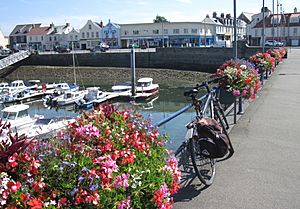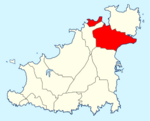Saint Sampson, Guernsey facts for kids
Quick facts for kids
Saint Sampson
|
||
|---|---|---|
 |
||
|
||

Location of Saint Sampson in Guernsey
|
||
| Crown Dependency | Guernsey, Channel Islands | |
| Area | ||
| • Total | 6.0 km2 (2.3 sq mi) | |
| Population
(2019)
|
||
| • Total | 8,966 | |
| • Density | 1,494/km2 (3,870/sq mi) | |
| Time zone | GMT | |
| • Summer (DST) | UTC+01 | |
St Sampson (in Guernésiais: Saint Samsaon) is a parish located on the island of Guernsey. It is part of the Bailiwick of Guernsey. This parish is found directly north of St Peter Port. It stretches along the north-west and north-east coasts of the island. The parish is divided into two parts by another area called Vale.
As of 2019, St Sampson has a population of 8,966 people. The people who live here are known as roînes. This Guernésiais word means "frogs."
The northern edge of the parish used to be the south coast of Le Braye du Valle. This was a tidal channel. It made the northern tip of Guernsey, called Le Clos du Valle, a tidal island. In 1806, the British Government drained and reclaimed La Braye du Valle. This was done for defense. The eastern part of the old channel became the town and harbour of St Sampson. This happened around 1820. Today, it is the second largest port in Guernsey. The western end of La Braye is now Le Grand Havre. A road called The Bridge crosses the harbour at St Sampson. It reminds people of the old bridge that once connected the two parts of Guernsey at high tide.
Contents
Exploring the History of St Sampson
The Oldest Church in Guernsey
The parish church of St Sampson is believed to be the oldest church in Guernsey. It stands on the coast where Samson of Dol arrived. He came from Brittany in the sixth century. His goal was to teach Christianity to the islanders. The church was officially opened on May 22, 1111. Antony Susar, the Bishop of Coutances, led the ceremony. Important people like Julien De Prade, the island's governor, were there. Richard D'Anneville, son of Sampson D'Anneville, also attended.
St Sampson is also the Patron Saint of Guernsey.
Life in St Sampson in the Past
In 1814, St Sampson had 125 homes. About 788 people lived there. The parish contributed one-thirteenth of all taxes collected in Guernsey.
Growth of the Harbour and Trade
The harbour facilities got better as more trade happened. In 1822, 7,000 tons of granite cobbles were shipped out. This was done using 90 ships. By 1836, the amount shipped each year grew to 57,584 tons. In 1841, the south quay was finished. By 1851, 542 ships were using the harbour every year. By 1861, granite exports reached 142,866 tons. This was carried by 737 ships. Today, the harbour is used for large items that don't fit in containers. This includes liquid and gas fuel.
Shipbuilding and Sea Journeys
Shipbuilding was an important activity in St Sampson. They built local trading boats. They also built a tea clipper named Golden Spur. A steamship called the Commerce was built in 1874. The Lydia, a local ship weighing 173 tons, sailed in March 1853. It went from St Sampson to Adelaide with 60 people moving there. The journey took 132 days.
Early Transport: Trams and Buses
Trams used to run from St Sampson to St Peter Port starting in 1879. Before that, a horse-drawn bus began operating in 1837. The first trams were powered by steam. They switched to electricity in 1891. Trams continued to run until 1934.
What to See and Do in St Sampson
|
St Sampson has many interesting places:
|
The parish of St Sampson is also home to:
|
St Sampson in Books
The famous book Toilers of the Sea (1866) was written by French author Victor Hugo. This story is set in the areas around St Sampson.
See also
 In Spanish: Saint Samsaon para niños
In Spanish: Saint Samsaon para niños



